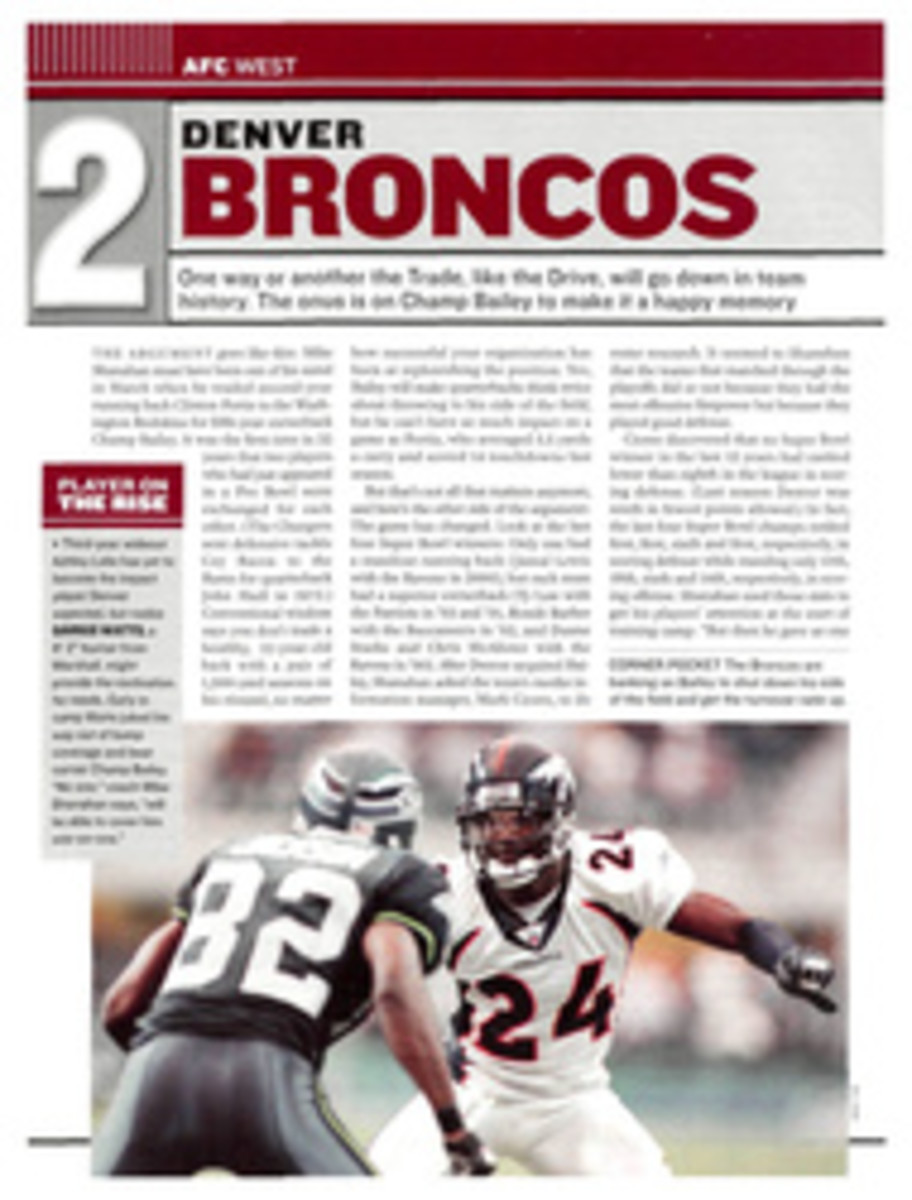
The Science of the Brief Encounter
After months of sparring, media spinning and nearly unanimous predictions that the trial would never happen, jury selection began last Friday in the Kobe Bryant sexual-assault case in Eagle, Colo. SI has seen previously undisclosed documents, which, in conjunction with court transcripts and interviews, are the basis for this report of how the trial may unfold.
Like most acquaintance rape cases, this one involves a man and a woman who entered a room, only to emerge with diametrically opposed versions of what happened there. The accuser's testimony will be the centerpiece of the state's case. But the physical evidence--genital injuries, blood and DNA--as well as Bryant's lengthy police statement will be crucial to both sides. Collection of this evidence began on July 1, 2003, about 12 hours after the incident, when Detective Doug Winters from the Eagle County Sheriff's Office and Deputy Marsha Rich went to the home of a 19-year-old college freshman to investigate her report of a sexual assault. Questioning the woman in the presence of her parents, Winters and Rich learned the man she was accusing was Kobe Bryant. The officers asked for the clothing she had worn the night before. Winters noticed what appeared to be a blood stain on a pair of purple panties. The officers took the woman and her clothing to the sheriff's office, where she gave a detailed videotaped statement.
Next her parents drove her to Valley View Hospital, where two nurses trained in sexual-assault cases conducted a rape-kit exam. SI has learned the exam revealed "multiple lacerations" and "bruises" between the vagina and anal opening. The nurses, noting the subject had not showered or douched since the encounter, described the injuries as genital "trauma" inconsistent with consensual sex.
Investigators then went to question Bryant, arriving at the Lodge & Spa at Cordillera, where the woman worked, roughly 24 hours after the alleged assault. Without receiving a Miranda warning or consulting a lawyer, Bryant spoke for 75 minutes to Winters and his partner, Dan Loya, who, unbeknownst to Bryant, had activated a concealed tape recorder. Most of the conversation has been admitted into evidence by trial judge Terry Ruckriegle. According to a report made available to SI, Bryant acknowledged talking with the woman. He told police they "shot the s---" but denied having sex with her. After the detectives said they had evidence to the contrary, Bryant admitted that he did have sex with the woman but denied any use of force. When asked how he knew the woman wanted to have sex, Bryant said he could tell from the look she gave him. Then he discussed with investigators something his accuser had not: oral sex. (The accuser told nurses at the hospital, who later told investigators, that Bryant made her kiss his penis and that she washed her face before leaving the room.)
In his interview with the detectives, Bryant remained cooperative and polite but expressed fears that his wife would find out about the incident and that it could ruin his career. When asked if he would pay his accuser to make the allegation go away, Bryant said that he would. After the interview, when the detectives executed a search warrant, Bryant took off his T-shirt, saying it was the same one he'd worn the previous night. It contained three smears of blood around the waist area. The officers then took Bryant to Valley View Hospital, where he provided body fluid samples and had his penis and other body parts swabbed. He was arrested two days later.
Whether Bryant testifies will probably not be determined until the prosecution rests. But despite his lawyers' efforts to have his statement and bloody shirt excluded, Ruckriegle deemed them admissible. Prosecutors will attempt to link the shirt to the injuries detected during the rape-kit exam. Those injuries are similar to the ones used as evidence by Greg Garrison when he successfully prosecuted Mike Tyson in Indianapolis in 1992 for raping a college freshman who willingly went to his hotel room and later said she was assaulted. Like Garrison, Colorado prosecutors will present graphic exhibits and medical testimony that the injuries are not consistent with consensual sex. Bryant's lawyers may try to minimize the injuries, but they are more likely to try to raise doubts about who caused them and use complicated DNA evidence to suggest it was someone other than Bryant. (The validity and admissibility of that evidence was challenged by prosecutors last week, but Ruckriegle had not ruled on the issue when SI went to press.)
When Bryant's accuser underwent her medical exam, swabs were taken from her vagina and thighs. Also, fabric samples were taken from the yellow underpants she wore to the exam and the purple pair worn during her encounter with Bryant. Initially, this evidence was analyzed by the Colorado Bureau of Investigation at the crime lab in Denver, which found that the pair worn to the exam contained a semen stain belonging to a man other than Bryant.
The defense subsequently ran its own forensic tests on the underwear and the swabs collected from the accuser. The analysis was performed by a private lab in Ventura, Calif., operated by Marc Taylor, a former L.A. Medical Examiner's Office criminalist who worked as an expert witness for the O.J. Simpson defense team. Taylor's lab reported that it found sperm from a man other than Bryant--identified as Mr. X--in both pairs of the accuser's underwear and on the swabs taken from her body.
At a closed-door hearing on June 21 and 22, DNA expert Elizabeth Johnson testified for the defense that the accuser's sexual contact with Mr. X "likely occurred after [the accuser] and Mr. Bryant were together." Johnson testified that no traces of Mr. X's DNA were detected on the swabs taken from Bryant or the T-shirt he wore. Johnson said that had Mr. X's sperm been on the accuser at the time of her encounter with Bryant, it should have shown up on Bryant.
Based on the publicly released DNA evidence in the case, Ronald Singer, president of the American Academy of Forensic Sciences, and Alan Keel, a criminalist and DNA expert, both told SI that Johnson's argument that Mr. X's fluids were deposited on the woman after her encounter with Bryant raises serious questions.
The accuser told investigators that she had sex about three days before meeting Bryant but no sex between that encounter and her exam. It has been reported that the DNA on the purple panties establishes that the accuser had sexual contact soon after her encounter with Bryant, but prosecutors have filed a document that says cotton cloth can retain semen even after it has been repeatedly "soaked or washed."
This does not explain sperm and semen on the swabs from the woman's body, but SI has learned that besides being a small sample, the DNA from Mr. X consisted of only the portions of sperm that remain after it has degraded over time. "Generally, when degraded sperm is all you see, it means several days have gone by," said Singer.
The responsibility for explaining this and rebutting Johnson's conclusions will likely fall to Dr. Henry Lee, the criminalist who, along with Marc Taylor, worked for the Simpson defense. But in the Bryant case Lee will testify for the prosecution, while Taylor is working for the defense.
What is Lee likely to say? He may make the point, as both DNA experts interviewed by SI did, that the small amount of sperm from Mr. X is inconsistent with a sexual encounter after one with Bryant. Keel and Singer also agree that semen swabbed from her leg could have been deposited there before she met Bryant--"but that presumes she didn't shower during that time," said Keel. Lee is also likely to attack the integrity of the defense's DNA analysis.
Although DNA has dominated the pretrial coverage, "this case could hinge on the blood," Singer says, referring to the fact that the stains on Bryant's T-shirt (and on the purple panties) were the accuser's blood. "Her blood on his T-shirt indicates her injuries were caused or reopened by him." There are two likely causes for vaginal bleeding: menstruation and trauma. Records obtained by SI indicate the accuser's period concluded nine days before her encounter with Bryant. "In cases of acquaintance rape, the presence of blood evidence is a touchdown for prosecutors," says Garrison, who did not have such evidence when he prosecuted Tyson.
Bryant's defense lawyers have attempted to admit evidence of the accuser's sexual history, but the judge has limited that to the 72 hours preceding her rape-kit exam. Garrison points out that all the pretrial publicity about the accuser's sex life may hurt her reputation but could help the state's case. "If she is sexually active," explained Garrison, "she is not going to hurt and bleed if she had consensual sex with Kobe. You only bleed if you don't want it to happen."
Though DNA has dominated the coverage, "this case could hinge on the blood."
"Excitement spread to the Braves' clubhouse where Curaçao native Andruw Jones followed the kids on TV."
--ISLE OF MIGHT, PAGE 28
COLOR ILLUSTRATION
ILLUSTRATION BY STEVE BRODNER

